Physical Address
304 North Cardinal St.
Dorchester Center, MA 02124
T he alimentary system (digestive system) is the digestive tract from the mouth to the anus, with all its associated glands and organs. The primordial gut forms during the fourth week as the head, caudal eminence (tail), and lateral folds incorporate the dorsal part of the umbilical vesicle (yolk sac; see Chapter 5 , Fig. 5.1 ). The primordial gut is initially closed at its cranial end by the oropharyngeal membrane (see Chapter 9 , Fig. 9.1 E ) and at its caudal end by the cloacal membrane ( Fig. 11.1 B ). The endoderm of the primordial gut and the surrounding splanchnic mesoderm form most of the gut, epithelium, and glands. Mesenchymal cells derived from the coelomic epithelium (epithelial–mesenchymal transformation) contribute to the mesoderm already surrounding the primordial gut and, moreover, are also involved in the formation of connective tissue and blood vessels in the gut. Mesenchymal factors, FoxF proteins, control proliferation of the endodermal epithelium that secretes sonic hedgehog (Shh). The epithelium of the cranial and caudal ends of the alimentary tract is derived from ectoderm of the stomodeum and anal pit (proctodeum), respectively (see Fig. 11.1 A and B ).
Fibroblast growth factors (FGFs) play an important role in early anteroposterior axial patterning, and it appears that FGF-4 signals from the adjacent ectoderm and mesoderm induce the endoderm. Other secreted factors, such as activins, members of the transforming growth factor-β superfamily, contribute to the formation of the endoderm . The endoderm specifies temporal and positional information, which is essential for the development of the gut. The muscular, connective tissue, and other layers of the wall of the alimentary tract are derived from the splanchnic mesenchyme surrounding the primordial gut.
For descriptive purposes, the primordial gut is divided into three parts: foregut, midgut, and hindgut. Molecular studies indicate that Hox and ParaHox genes, as well as Shh, BMP, and Wnt signals, regulate the regional differentiation of the primordial gut to form its three parts .
The derivatives of the foregut are as follows:
Primordial pharynx and its derivatives
Lower respiratory system
Esophagus and stomach
Duodenum, proximal to the opening of the bile duct
Liver, biliary apparatus (hepatic ducts, gallbladder, and bile duct), and pancreas
These foregut derivatives, other than the pharynx, lower respiratory tract, and most of the esophagus, are supplied by the celiac trunk , the artery of the foregut (see Fig. 11.1 B ).
10
The esophagus develops from the foregut immediately caudal to the pharynx (see Fig. 11.1 B ). The partitioning of the trachea from the esophagus by the tracheoesophageal septum is described in Chapter 10 , Fig. 10.2 E . Initially, the esophagus is short, but it elongates rapidly, mainly because of the growth and relocation of the heart and lungs.
The esophagus reaches its final relative length by the seventh week. Its epithelium and glands are derived from endoderm that proliferates and, partly or completely, obliterates the lumen of the esophagus. However, recanalization of the esophagus normally occurs by the end of the eighth week. The striated muscle forming the muscularis externa (external muscle) of the superior third of the esophagus is derived from mesenchyme in the fourth and sixth pharyngeal arches. The smooth muscle , mainly in the inferior third of the esophagus, develops from the surrounding splanchnic mesenchyme.
Recent studies indicate transdifferentiation of smooth muscle cells in the superior part of the esophagus to striated muscle, which is dependent on myogenic regulatory factors. Both types of muscle are innervated by branches of the vagus nerves (cranial nerve X), which supply the caudal pharyngeal arches (see Chapter 9 , Table 9.1 ).
Atresia (blockage) of the esophageal lumen occurs with an incidence of 1 in 3000 to 4500 neonates. Approximately one third of affected infants are born prematurely. This defect is associated with tracheoesophageal fistula in more than 90% of cases (see Chapter 10 , Fig. 10.6 ). Esophageal atresia results from deviation of the tracheoesophageal septum in a posterior direction (see Chapter 10 , Fig. 10.7 ) and incomplete separation of the esophagus from the laryngotracheal tube. Isolated atresia (5% to 7% of cases) results from failure of recanalization of the esophagus during the eighth week of development.
A fetus with esophageal atresia is unable to swallow amniotic fluid; consequently, the fluid cannot pass to the intestine for absorption and transfer through the placenta to the maternal blood for disposal. This results in polyhydramnios , the accumulation of an excessive amount of amniotic fluid. Neonates with esophageal atresia usually appear healthy initially. Excessive drooling may be noted soon after birth, and the diagnosis of esophageal atresia should be considered if the baby rejects oral feeding with immediate regurgitation and coughing.
Inability to pass a catheter through the esophagus into the stomach strongly suggests esophageal atresia. A radiographic examination demonstrates the defect by imaging the nasogastric tube arrested in the proximal esophageal pouch. In neonates weighing more than 2 kg and without associated cardiac anomalies, the survival rate now approaches 100% with surgical repair. As the birth weight decreases and cardiovascular anomalies become more severe, the survival rate decreases to as low as 1%.
Stenosis (narrowing) of the lumen of the esophagus can occur anywhere along the esophagus, but it usually occurs in its distal third, either as a web or a long segment with a thread-like lumen. Stenosis results from incomplete recanalization of the esophagus during the eighth week or from a failure of esophageal blood vessels to develop in the affected area.
10
Initially the distal part of the foregut is a tubular structure (see Fig. 11.1 B ). During the fourth week, a slight dilation indicates the site of the primordial stomach. The dilation first appears as a fusiform enlargement of the caudal (distal) part of the foregut and is initially oriented in the median plane (see Figs. 11.1 and 11.2 B ). The left wall of the primordial stomach soon enlarges and broadens ventrodorsally. During the next 2 weeks, on account of the polarization and radial rearrangement of the epithelium, the dorsal border of the right wall of the stomach grows faster than its ventral border; this demarcates the developing greater curvature of the stomach (see Fig. 11.2 D ). Such left-right asymmetry and rotation of the gut are regulated by extrinsic forces and the expression of left-right patterning genes (Foxj1, Nodal) and Pitx2) .
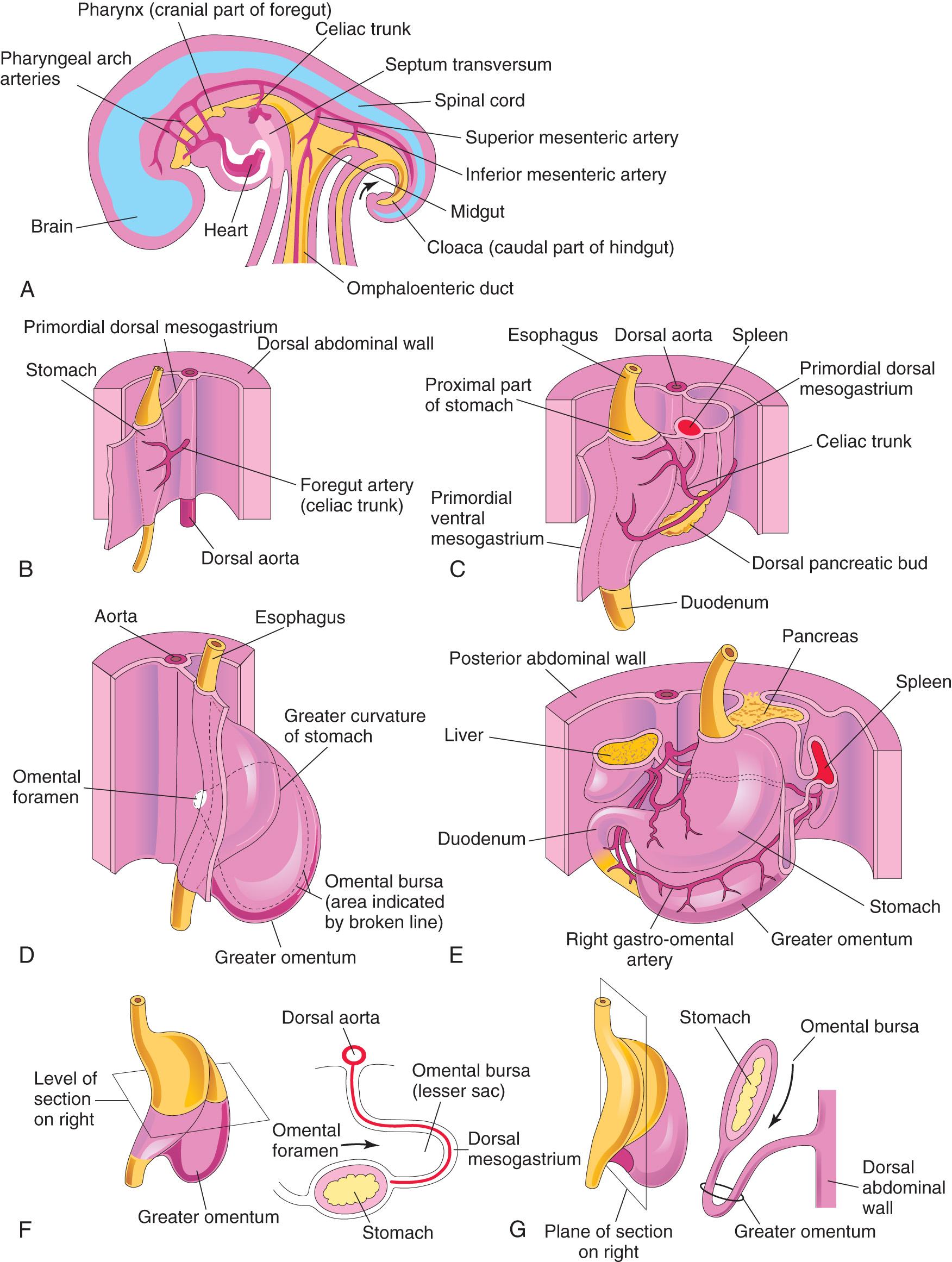
Changes in the position and relocation of the stomach and intestine are described as a passive rotation. Enlargement of the mesentery and adjacent organs, as well as growth of the stomach walls, contributes to the rotation of the stomach. As the stomach enlarges and acquires its final shape, it slowly rotates 90 degrees in a clockwise direction (viewed from the cranial end) around its longitudinal axis. The effects of rotation on the stomach are as follows ( Figs. 11.2 and 11.3 ):
The ventral border (lesser curvature) moves to the right, and the dorsal border (greater curvature) moves to the left (see Fig. 11.2 C and F ).
The original left side becomes the ventral surface, and the original right side becomes the dorsal surface.
Before rotation, the cranial and caudal ends of the stomach are in the median plane (see Fig. 11.2 B ). During rotation and growth of the stomach, its cranial region moves to the left and slightly inferiorly, and its caudal region moves to the right and superiorly.
After rotation, the stomach assumes its final position, with its long axis almost transverse to the long axis of the body (see Fig. 11.2 E ).

The rotation and growth of the stomach explain why the left vagus nerve supplies the anterior wall of the adult stomach and the right vagus nerve innervates its posterior wall.
The stomach is suspended from the dorsal wall of the abdominal cavity by a dorsal mesentery, the primordial dorsal mesogastrium (see Figs. 11.2 B and C and 11.3 A ). This mesentery, originally in the median plane, is carried to the left during rotation of the stomach and formation of the omental bursa or lesser sac of the peritoneum (see Fig. 11.3 A to E ). The mesentery also contains the spleen and celiac artery. The primordial ventral mesogastrium attaches to the stomach; it also attaches the duodenum to the liver and ventral abdominal wall (see Figs. 11.2 C and 11.3 A and B ).
10
Isolated clefts develop in the mesenchyme, forming the thick dorsal mesogastrium (see Fig. 11.3 A and B ). The clefts soon coalesce to form a single cavity, the omental bursa or lesser peritoneal sac (see Fig. 11.3 C and D ). Rotation of the stomach pulls the mesogastrium to the left, thereby enlarging the bursa, a large recess in the peritoneal cavity. The bursa expands transversely and cranially and soon lies between the stomach and posterior abdominal wall. The pouch-like bursa facilitates movements of the stomach (see Fig. 11.3 H ).
The superior part of the omental bursa is cut off as the diaphragm develops, forming a closed space, the infracardiac bursa . If the space persists, it usually lies medial to the base of the right lung. The inferior region of the superior part of the bursa persists as the superior recess of the omental bursa (see Fig. 11.3 C ).
As the stomach enlarges, the omental bursa expands and acquires an inferior recess of the omental bursa between the layers of the elongated dorsal mesogastrium, the greater omentum (see Fig. 11.3 J ). This membrane overhangs the developing intestines. The inferior recess disappears as the layers of the greater omentum fuse (see Fig. 11.15 F ). The omental bursa communicates with the peritoneal cavity through an opening, the omental foramen (see Figs. 11.2 D and F and 11.3 C and F ).
Anomalies of the stomach are uncommon, except for hypertrophic pyloric stenosis . This defect affects one in every 150 males and one in every 750 females. In infants there is a marked muscular thickening of the pylorus , the distal sphincteric region of the stomach ( Fig. 11.4 A and B ). The circular muscles and, to a lesser degree, the longitudinal muscles in the pyloric region are hypertrophied (increased in bulk). This results in severe stenosis of the pyloric canal and obstruction of the passage of food. As a result, the stomach becomes markedly distended (see Fig. 11.4 C ), and the infant expels the stomach's contents with considerable force (projectile vomiting).
Surgical relief of the pyloric obstruction by pyloromyotomy , in which a longitudinal incision is made through the anterior wall of the pyloric canal, is the usual treatment. The cause of congenital pyloric stenosis is unknown, but the high rate of concordance in monozygotic twins suggests genetic factors may be involved.
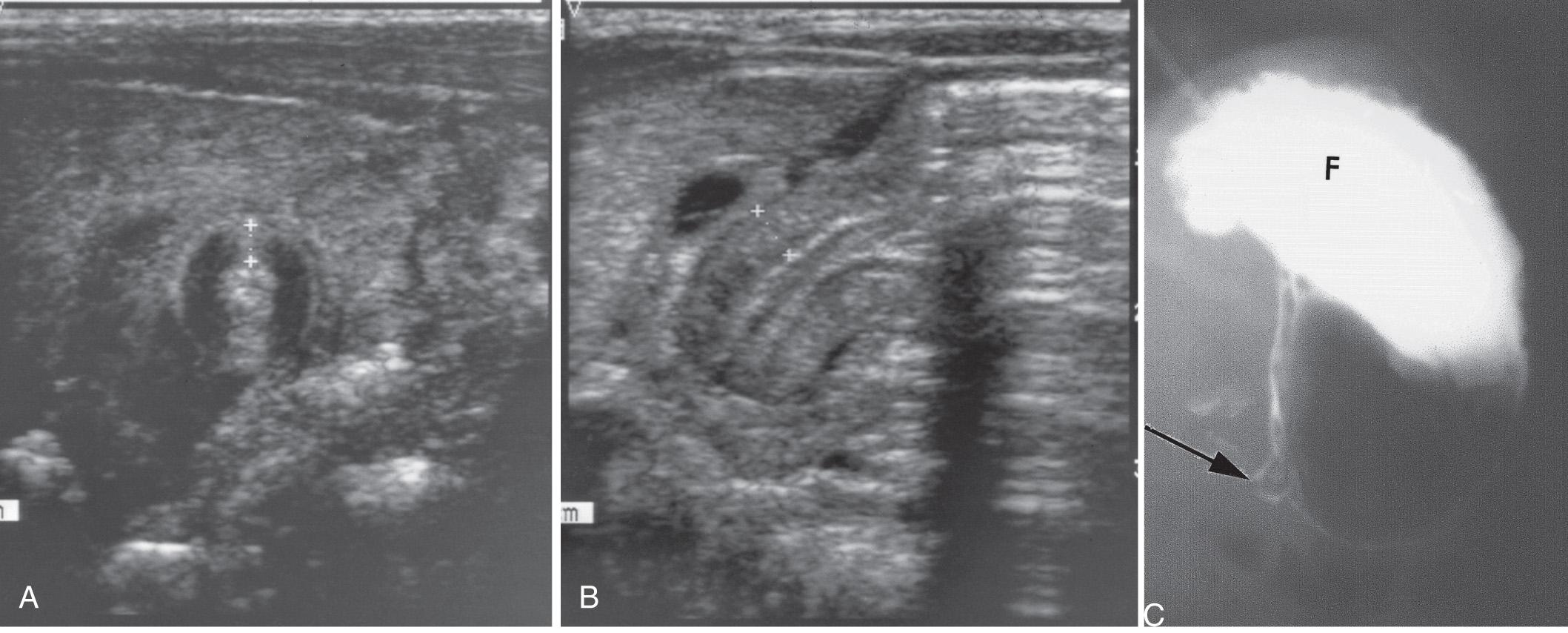
10
Early in the fourth week, the duodenum begins to develop from the caudal part of the foregut, cranial part of the midgut, and splanchnic mesenchyme associated with these parts of the primordial gut ( Fig. 11.5 A ). The junction of the two parts of the duodenum is just distal to the origin of the bile duct (see Fig. 11.5 D ). The developing duodenum grows rapidly, forming a C -shaped loop that projects ventrally (see Fig. 11.5 B to D ).
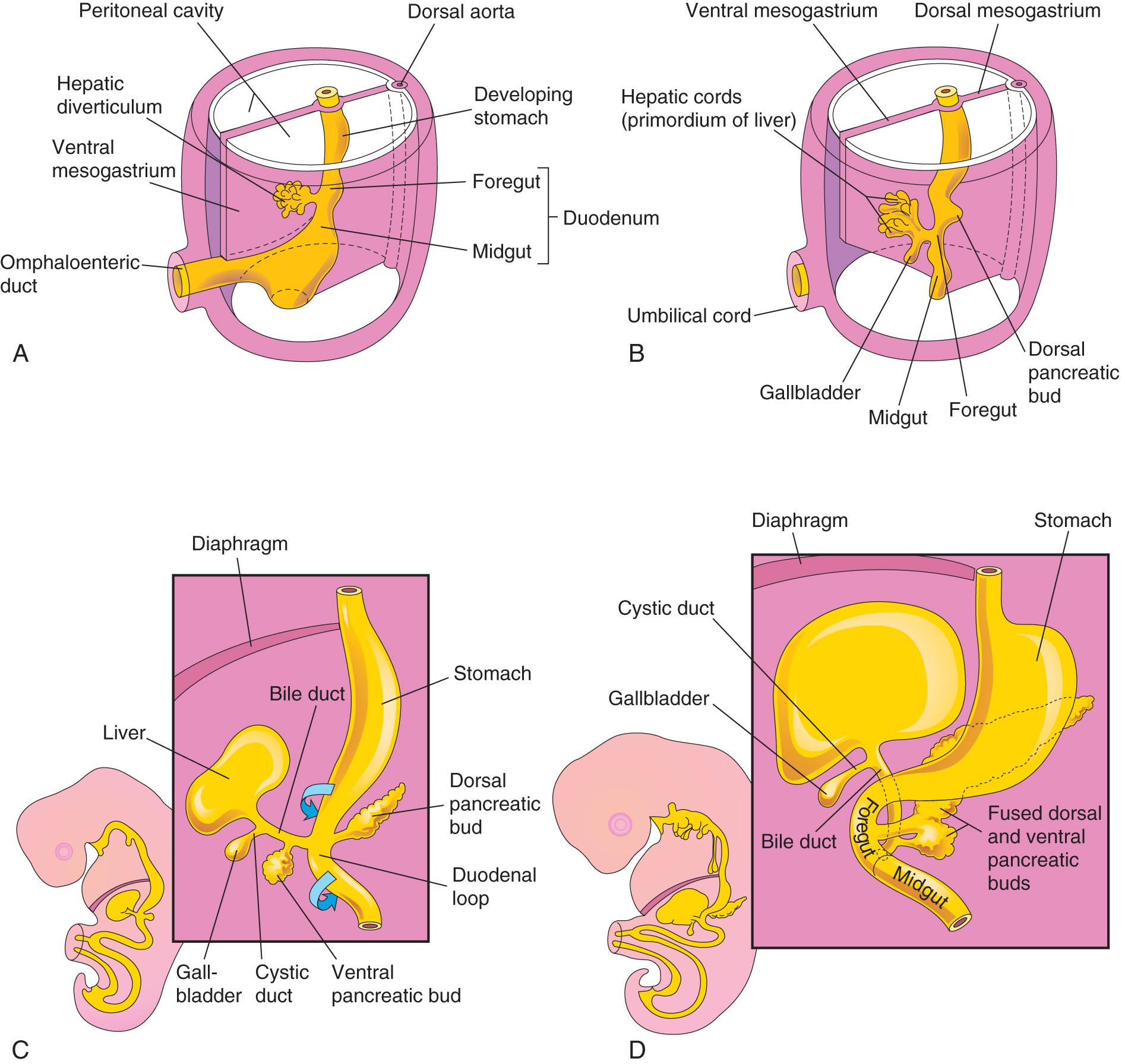
As the stomach rotates, the duodenal loop rotates to the right and is pressed against the posterior wall of the abdominal cavity, or in a retroperitoneal position (external to the peritoneum). Because of its derivation from the foregut and midgut, the duodenum is supplied by branches of the celiac trunk and superior mesenteric arteries that supply these parts of the primordial gut (see Fig. 11.1 ).
During the fifth and sixth weeks, the lumen of the duodenum becomes progressively smaller and is temporarily obliterated because of proliferation of its epithelial cells. Normally, vacuolation occurs as the epithelial cells degenerate; as a result, the duodenum normally becomes recanalized by the end of the embryonic period ( Fig. 11.6 C and D ). By this time, most of the ventral mesentery of the duodenum has disappeared.
Partial occlusion of the duodenal lumen, or duodenal stenosis (see Fig. 11.6 A ), usually results from incomplete recanalization of the duodenum, resulting from defective vacuolation (see Fig. 11.6 E and E 3 ). Most stenoses involve the horizontal (third) and/or ascending (fourth) parts of the duodenum. Because of the stenosis, the stomach's contents (usually containing bile) are often vomited.
Complete occlusion of the duodenal lumen, or duodenal atresia (see Fig. 11.6 B ), is not common. During early duodenal development, the lumen is completely occluded by epithelial cells. If complete recanalization of the lumen fails to occur (see Fig. 11.6 D 3 ), a short segment of the duodenum is occluded (see Fig. 11.6 F 3 ). The blockage usually occurs at the junction of the bile duct and pancreatic duct, or hepatopancreatic ampulla , a dilated area within the major duodenal papilla that receives the bile duct and main pancreatic duct; occasionally, the blockage involves the horizontal (third) part of the duodenum. Investigation of families with familial duodenal atresia suggests an autosomal recessive inheritance pattern.
In neonates with duodenal atresia, vomiting begins a few hours after birth. The vomitus almost always contains bile; often there is distention of the epigastrium, the upper central area of the abdomen, resulting from an overfilled stomach and superior part of the duodenum. The atresia is associated with bilious emesis (vomiting of bile) because the blockage occurs distal to the opening of the bile duct. The atresia may occur as an isolated birth defect, but other defects are often associated with it, such as annular pancreas (see Fig. 11.11 C ), cardiovascular defects, anorectal defects, and malrotation of the gut (see Fig. 11.20 ). The presence of nonbilious emesis does not exclude duodenal atresia as a diagnosis because some infants will have obstruction proximal to the ampulla. Importantly, approximately one third of affected infants have Down syndrome, and an additional 20% are premature.
Polyhydramnios also occurs because duodenal atresia prevents normal intestinal absorption of swallowed amniotic fluid. The diagnosis of duodenal atresia is suggested by the presence of a “double-bubble” sign on plain radiographs and ultrasound scans ( Fig. 11.7 ). This appearance is caused by a distended, gas-filled stomach and the proximal duodenum.
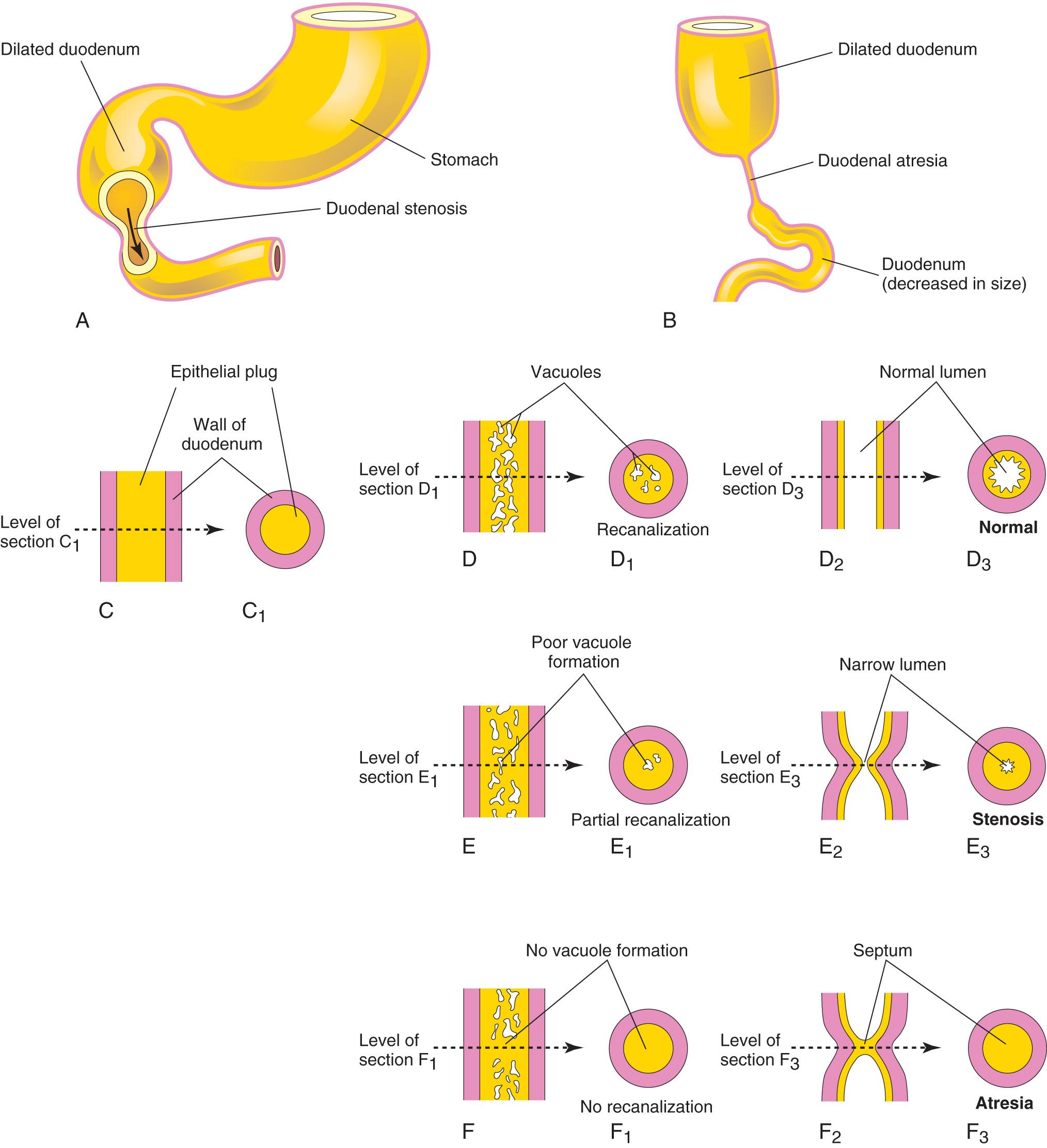
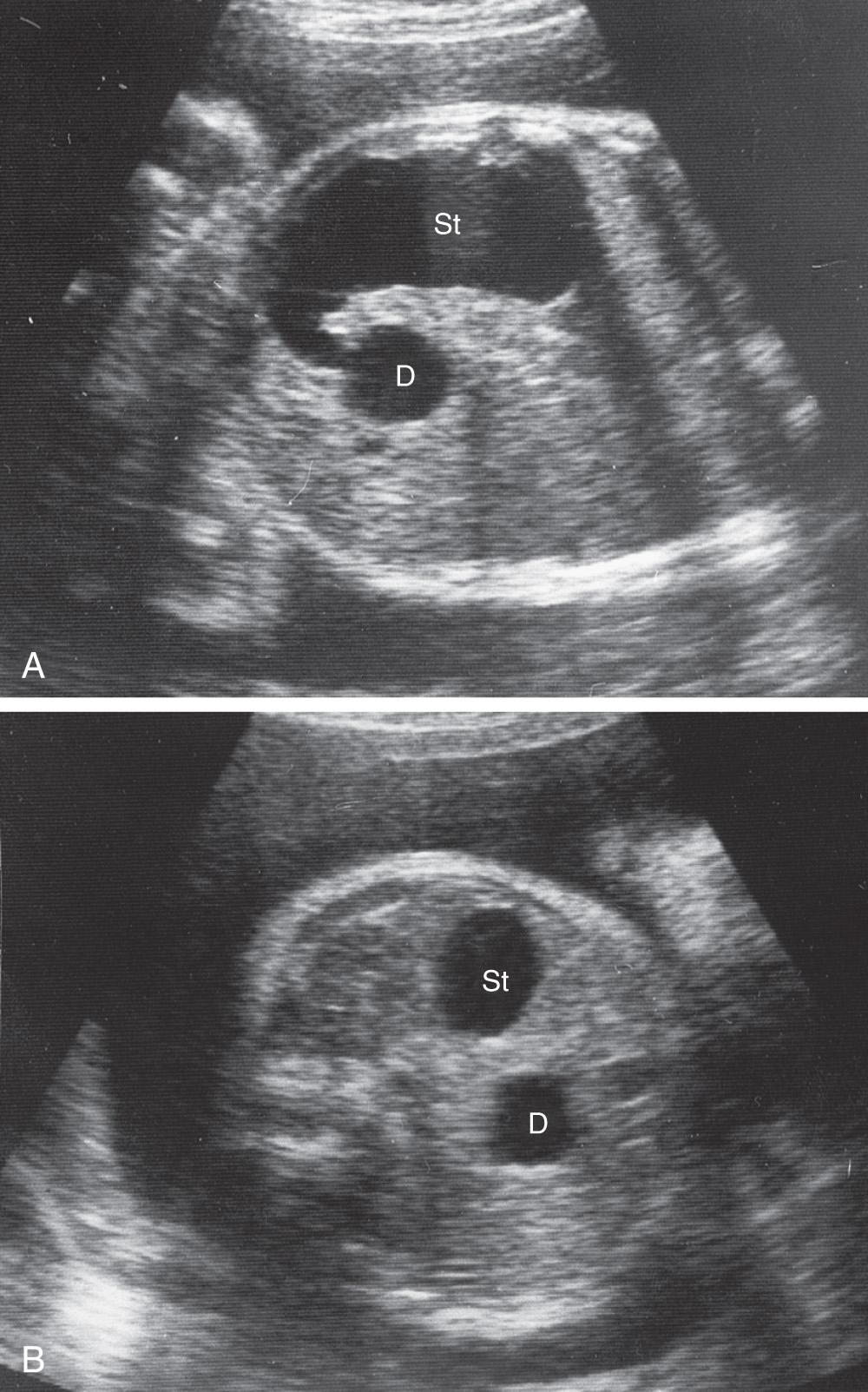
10
The liver, gallbladder, and biliary duct system arise as a ventral endodermal outgrowth, the hepatic diverticulum , from the distal part of the foregut early in the fourth week ( Fig. 11.8 A , and see also Fig. 11.5 A ). The Wnt/β−catenin signaling pathway plays a key role in this process, which includes the proliferation and differentiation of the hepatic progenitor cells (hepatoblasts) to form hepatocytes and cholangiocytes (epithelial cells of the intrahepatic bile ducts). Both the hepatic diverticulum and the ventral bud of the pancreas develop from two cell populations in the embryonic endoderm. At sufficient levels, FGFs secreted by the developing heart interact with the bipotential cells and induce the formation of the hepatic diverticulum.
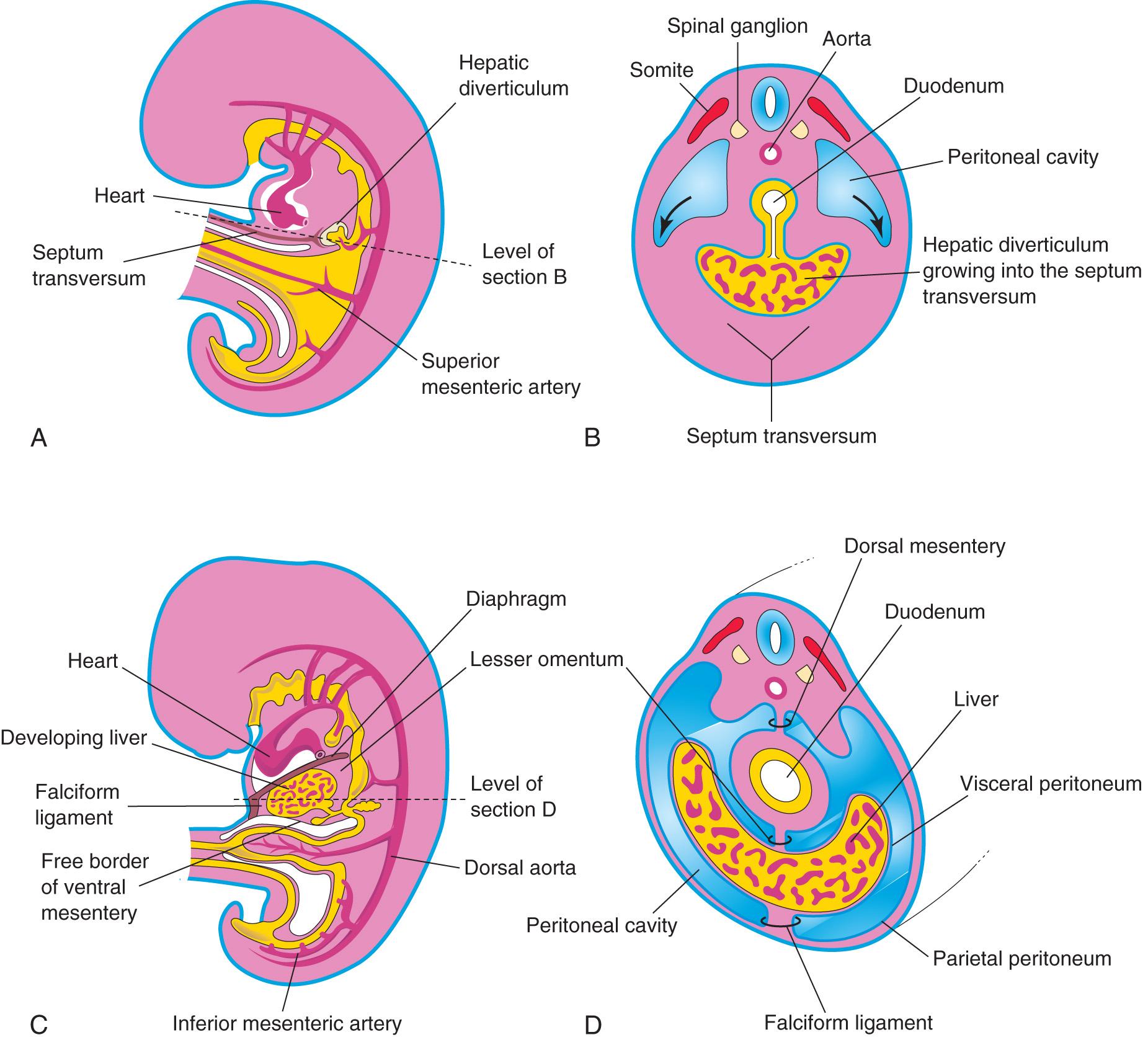
The diverticulum invades into the septum transversum , a mass of splanchnic mesoderm separating the pericardial and peritoneal cavities. The septum forms the ventral mesogastrium in this region. The hepatic diverticulum enlarges rapidly and divides into two parts as it grows between the layers of the ventral mesogastrium , or mesentery of the dilated portion of the foregut and the future stomach (see Fig. 11.5 A ).
The larger cranial part of the hepatic diverticulum is the primordium of the liver (see Figs. 11.8 A and C and 11.10 A and B ); the smaller caudal part becomes the primordium of the gallbladder . The proliferating endodermal cells form interlacing cords of hepatocytes and give rise to the epithelial lining of the intrahepatic part of the biliary apparatus. The hepatic cords anastomose around endothelium-lined spaces, the primordia of the hepatic sinusoids . Vascular endothelial growth factor Flk-1 signaling appears to be important for the early morphogenesis of the hepatic sinusoids (primitive vascular system). The fibrous and hematopoietic tissues are derived from mesenchyme in the septum transversum, whereas Kupffer cells of the liver originate from precursors from the umbilical vesicle. Development of the intrahepatic biliary system depends on Notch signaling.
The liver grows rapidly from the 5th to 10th weeks and fills a large part of the upper abdominal cavity (see Fig. 11.8 C and D ). The quantity of oxygenated blood flowing from the umbilical vein into the liver determines the development and functional segmentation of the liver. Initially, the right and left lobes are approximately the same size, but the right lobe soon becomes larger.
Hematopoiesis (formation and development of various types of blood cells) begins in the liver during the sixth week, with hematopoietic stem cells migrating from the dorsal aorta to the liver. The formation of blood gives the liver a bright reddish appearance. By the ninth week, the liver accounts for approximately 10% of the total weight of the fetus. Bile formation by hepatic cells begins during the 12th week.
The small caudal part of the hepatic diverticulum becomes the gallbladder , and the stalk of the diverticulum forms the cystic duct (see Fig. 11.5 C ). Initially, the extrahepatic biliary apparatus is occluded with epithelial cells, but it is later canalized because of vacuolation resulting from degeneration of these cells. The cholangiocytes (epithelial cells) of the extrahepatic ducts are derived from endoderm.
The stalk of the diverticulum connecting the hepatic and cystic ducts to the duodenum becomes the bile duct . Initially, this duct attaches to the ventral aspect of the duodenal loop; however, as the duodenum grows and rotates, the entrance of the bile duct is carried to the dorsal aspect of the duodenum (see Fig. 11.5 C and D ). The bile entering the duodenum through the bile duct after the 13th week gives the meconium (intestinal discharges of the fetus) a dark green color.
The ventral mesentery , a thin, double-layered membrane (see Fig. 11.8 C and D ), gives rise to:
The lesser omentum , passing from the liver to the lesser curvature of the stomach (hepatogastric ligament) and from the liver to the duodenum (hepatoduodenal ligament)
The falciform ligament , extending from the liver to the ventral abdominal wall
The umbilical vein passes through the free border of the falciform ligament on its way from the umbilical cord to the liver. The ventral mesentery, derived from the mesogastrium, also forms the visceral peritoneum of the liver. The liver is covered by peritoneum, except for the bare area , which is in direct contact with the diaphragm ( Fig. 11.9 ).
Minor variations of liver lobulation are common; however, birth defects of the liver are rare. Variations of the hepatic ducts, bile duct, and cystic duct are common and clinically significant. Accessory hepatic ducts are present in approximately 5% of the population, and awareness of their possible presence is of importance in surgery (e.g., liver transplantation). The accessory ducts are narrow channels running from the right lobe of the liver into the anterior surface of the body of the gallbladder. In some cases, the cystic duct opens into an accessory hepatic duct rather than into the common hepatic duct.
Extrahepatic biliary atresia is the most serious defect of the extrahepatic biliary system, and it occurs in 1 in 5000 to 20,000 live births. The most common form of extrahepatic biliary atresia (present in 85% of cases) is obliteration of the bile ducts at or superior to the porta hepatis, a deep transverse fissure on the visceral surface of the liver.
Previous speculations that there is a failure of the bile ducts to canalize may not be true. Biliary atresia (absence of a normal opening) of the major bile ducts could result from a failure of the remodeling process at the hepatic hilum from viral infections, immunologic reactions, or defects of circulation during late fetal development.
Jaundice occurs soon after birth, the stools are acholic (clay colored), and the urine appears dark colored. Biliary atresia can be palliated surgically in most patients, but in more than 70% of those treated, the disease continues to progress.
Agenesis of the gallbladder occurs rarely and is usually associated with the absence of the cystic duct.
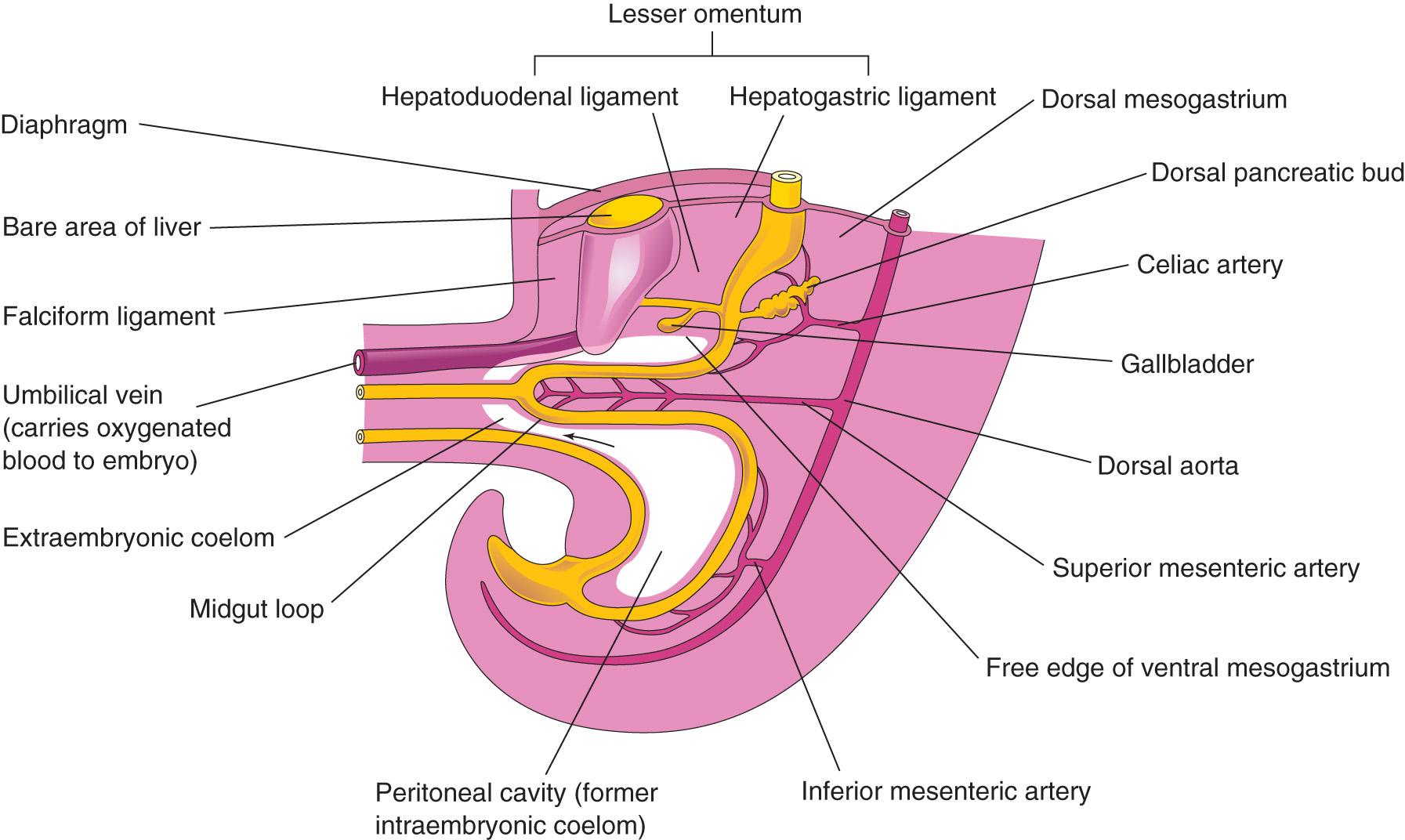
10
The pancreas develops between the layers of the mesentery from dorsal and ventral pancreatic buds of endodermal cells, which arise from the caudal part of the foregut ( Fig. 11.10 A and B , and see also Fig. 11.9 ). Most of the pancreas is derived from the larger dorsal pancreatic bud , which appears first and develops at a slight distance cranial to the ventral bud.
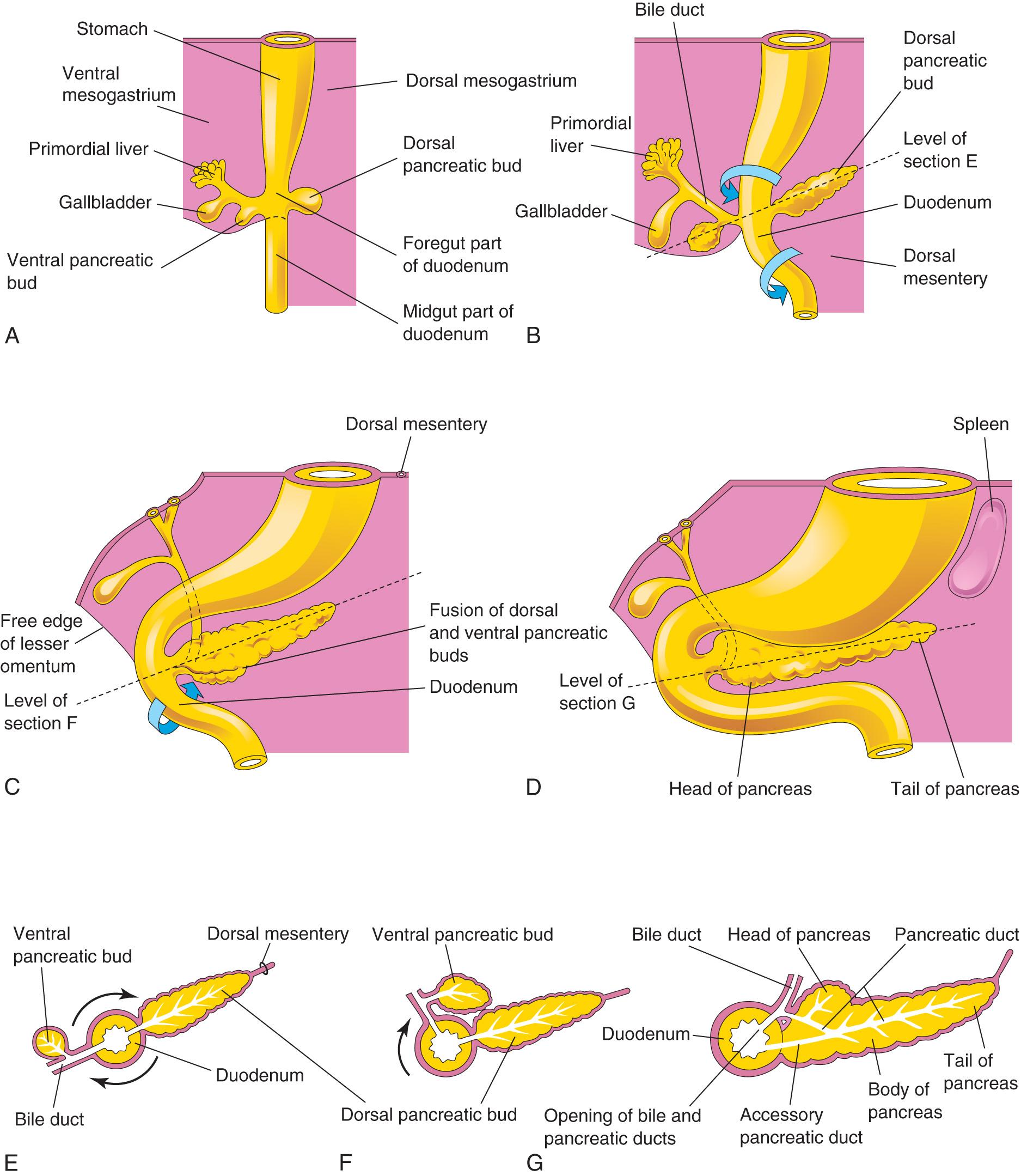
The smaller ventral pancreatic bud develops near the entry of the bile duct into the duodenum and grows between the layers of the ventral mesentery. As the duodenum rotates to the right and becomes C shaped, the bud is carried dorsally with the bile duct (see Fig. 11.10 C to G ). It soon lies posterior to the dorsal pancreatic bud and later fuses with it. The ventral pancreatic bud forms the uncinate process and part of the head of the pancreas .
As the stomach, duodenum, and ventral mesentery rotate, the pancreas comes to lie along the dorsal abdominal wall (in a retroperitoneal position). As the pancreatic buds fuse, their ducts anastomose, or open into one another (see Fig. 11.10 C ). The pancreatic duct forms from the duct of the ventral bud and the distal part of the duct of the dorsal bud (see Fig. 11.10 G ). The proximal part of the duct of the dorsal bud often persists as an accessory pancreatic duct that opens into the minor duodenal papilla , located approximately 2 cm cranial to the main duct (see Fig. 11.10 G ). The two ducts often communicate with each other. In approximately 9% of people, the pancreatic ducts fail to fuse, resulting in two ducts.
Molecular studies show that the ventral pancreas develops from a bipotential cell population in the ventral region of the duodenum where the transcription factor PDX1 is expressed. A default mechanism involving FGF-2, which is secreted by the developing heart, appears to play a role. Formation of the dorsal pancreatic bud depends on the notochord secreting activin and FGF-2, which block the expression of Shh in the associated endoderm, and the transcription factor Myte, which is expressed in the endocrine progenitor cells of the pancreas .
Become a Clinical Tree membership for Full access and enjoy Unlimited articles
If you are a member. Log in here